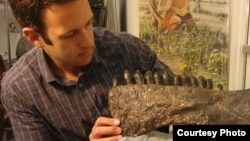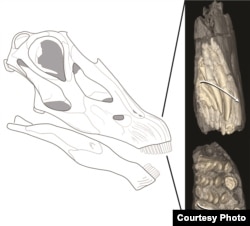Certain plant-eating dinosaurs wore out their teeth chewing on all of that vegetation, but new chompers quickly grew in to replace them, according to new research.
Two of the prehistoric world's largest dinosaurs - Diplodocus and Camarasaurus - lived side by side for millions of years, and although they occupied the same ecosystem, and were both herbivores, they did not compete for the same kind of food.
Stony Brook University paleontologist Michael D’Emic wanted to know why. So, as if they were paleo-dentists, D’Emic and his team removed teeth encased in fossil skulls of the two animals to look for clues.
“We looked at their tooth shapes, their tooth sizes, and their tooth formation and replacement rates," he said, "and we found that these things were very different in these two animals.”
The distantly related sauropods also had different body types. Diplodocus had low slung shoulders, a horse shaped skull, a tremendously elongated neck and a whip-like tail. Camarasaurus had a shorter neck and thicker tail, larger teeth and a broader skull.
In the late Jurassic period, some 150 million years ago, both species fed on ferns and tough evergreen vegetation like conifers, which could wear teeth down quickly. But sauropod teeth grew rapidly; when one tooth fell out, another was already lined up to replace it.
These extinct herbivores lost and replaced teeth at a remarkable rate. D'Emic called Diplodocus an extreme case.
"So, it would have had a new tooth in each tooth socket about every month. Camarasaurus, a little bit slower, about one every two months," he said. "Now because Camarasaurus’ teeth are so much bigger and broader than were Diplodocus’, it was actually producing and going through a lot more material faster.”
D’Emic said feeding habits were a factor in the survival of these two giants in the same ecosystem. Camarasaurus took a quality over quantity approach to its diet, while Diplodocus grazed with its head on the ground eating as much, as fast as it could.
Studies like his, D’Emic said, bring the daily life of dinosaurs alive for people today.
Two of the prehistoric world's largest dinosaurs - Diplodocus and Camarasaurus - lived side by side for millions of years, and although they occupied the same ecosystem, and were both herbivores, they did not compete for the same kind of food.
Stony Brook University paleontologist Michael D’Emic wanted to know why. So, as if they were paleo-dentists, D’Emic and his team removed teeth encased in fossil skulls of the two animals to look for clues.
“We looked at their tooth shapes, their tooth sizes, and their tooth formation and replacement rates," he said, "and we found that these things were very different in these two animals.”
The distantly related sauropods also had different body types. Diplodocus had low slung shoulders, a horse shaped skull, a tremendously elongated neck and a whip-like tail. Camarasaurus had a shorter neck and thicker tail, larger teeth and a broader skull.
In the late Jurassic period, some 150 million years ago, both species fed on ferns and tough evergreen vegetation like conifers, which could wear teeth down quickly. But sauropod teeth grew rapidly; when one tooth fell out, another was already lined up to replace it.
These extinct herbivores lost and replaced teeth at a remarkable rate. D'Emic called Diplodocus an extreme case.
"So, it would have had a new tooth in each tooth socket about every month. Camarasaurus, a little bit slower, about one every two months," he said. "Now because Camarasaurus’ teeth are so much bigger and broader than were Diplodocus’, it was actually producing and going through a lot more material faster.”
D’Emic said feeding habits were a factor in the survival of these two giants in the same ecosystem. Camarasaurus took a quality over quantity approach to its diet, while Diplodocus grazed with its head on the ground eating as much, as fast as it could.
Studies like his, D’Emic said, bring the daily life of dinosaurs alive for people today.








